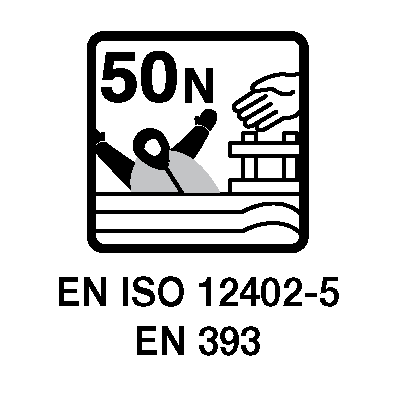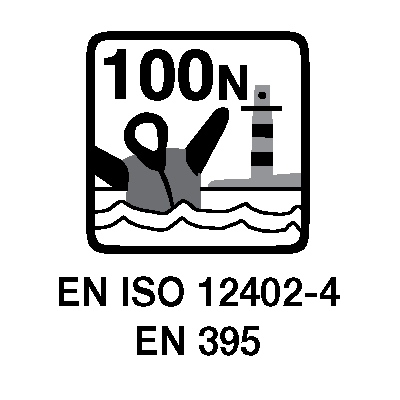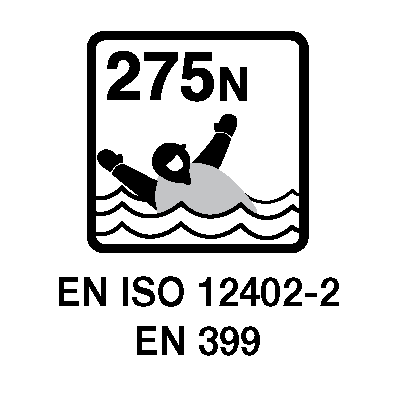Maritime PPE standards
EN 393 / EN ISO 12402-5: 50N BUOYANCY AIDS
Have a buoyancy of no less than 50 Newton for the average adult. This level is intended for use by those who are competent swimmers and who are near to bank or shore, or who have help and a means of rescue close at hand. These garments have minimal bulk, but they are of limited use in disturbed water, and cannot be expected to keep the user safe for a long period of time. They do not have sufficient buoyancy to protect people who are unable to help themselves. They require active participation by the user.
EN 395 / EN ISO12402-4: 100N LIFE JACKETS
Have buoyancy of no less than 100 Newton for the average adult. This level is intended for those who may have to wait for rescue, but are likely to do so in sheltered water. The device should not be used in rough conditions.
EN 396 / EN ISO 12402-3: 150N LIFE JACKETS
Have buoyancy of no less than 150 Newton for the average adult. This level is intended for general application or for use with foul weather clothing.
EN 399 / EN ISO 12402-2: 275N LIFE JACKETS
Have buoyancy of no less than 275 Newton for the average adult. This level of lifejacket is intended primarily for offshore use under extreme conditions. It is also of value to those who are wearing clothing which traps air or loads such as tool belts which may adversely affect the self-righting capacity of the lifejacket.
IMO / SOLAS / MED
The International Maritime Organisation governs the Convention of Safety Of Life at Sea - SOLAS. This Convention requires that SOLAS requirements are met for all life-saving equipment carried and used on board all ships on international voyages including passenger ships and cargo ships of 500 gross tonnes or more. This includes lifejackets, abandonment suits and immersion suits. Recognition that the equipment fully complies with the requirements of the MED - Marine Equipment Directive - will be denoted by a ‘Ships Steering Wheel’ mark which must be on all equipment sold to European Community Ships of 500 tons or more in size.
SOLAS LIFEJACKETS
All lifejackets must be of double chamber design with 2 automatic inflation systems as well as be fitted with a SOLAS approved light and buddy line for optimum safety.
SOLAS IMMERSION + ANTI-EXPOSURE SUITS
These Immersion and Anti-Exposure Suits should provide the highest level of safety and performance. They incorporate inherent buoyancy which gives the wearer flotation and thermal protection in order to provide the optimum chance of survival and rescue before any negative effects of cold water immersion set in and to protect against the risks of drowning. In accordance with the SOLAS requirements, according to the LSA Code, Chapter II, 2.3:
- Where required as Immersion suits, they are designed to cover the whole body (including boots to cover the feet), with the exception of the face and with separate gloves that are permanently attached to the suit.
- Where required as Anti-Exposure suits only, they can be designed and supplied without the boots fitted (as permitted by the Administration) and equipped with a pocket for a portable VHF radio / telephone.
An un-insulated immersion suit or anti-exposure suit is intended to provide the wearer with up to 1 hour protection in a water temperature range of > 5°C
An insulated immersion suit is intended to provide the wearer with up to 6 hours protection in a water temperature range of > 0°C.
These suits are designed to be worn in conjunction with a compatible SOLAS / MED approved lifejacket.
EN ISO 15027-1: CONSTANT WEAR SUITS
A constant wear suit is designed to be worn as a working suit to keep the wearer warm and dry during normal activities and to provide thermal protection in the event of accidental immersion, to prolong life and to aid rescue. An individual’s estimated thermal protection time when wearing this type of equipment will depend upon the water temperature, weather conditions, clothing, the cold tolerance of the person and the person’s behaviour. The primary aims in wearing a constant wear suit are:
- to reduce the risk of cold shock and to delay the onset of hypothermia;
- to enable the user to propel himself in the water and extricate himself from the water without it becoming an encumbrance;
- to make the user sufficiently conspicuous in the water so as to aid his recovery.
Immersed CLO
| D |
C |
B |
A |
| 0,2 |
0,33 |
0,5 |
0,75 |
Estimated protection time
| Water temperature |
D |
C |
B |
A |
| <5°C |
1h |
1,5h |
2,5h |
6h |
| 5°-10°C |
1,5h |
2,5h |
4,5h |
9h |
| 10°-15°C |
2h |
4h |
7h |
15h |
| > 15°C |
3h |
6h |
15h |
24h |
ISO 15027-2: ABANDONMENT SUITS
An abandonment suit is designed to be donned in an emergency or planned abandon ship situation and will provide protection from cold shock and delay the onset of hypothermia. The complete immersion system (suit and clothes worn under the suit) should be able to keep the user alive long enough for the rescue services to find and recover them. An individual’s estimated thermal protection time will depend on water temperature and wave state as well as their physiology. The primary aims in wearing an abandonment suit are:
- to reduce the risk of cold shock and delay the onset of hypothermia;
- to enable the user to propel himself in the water and extricate himself from the water without it becoming an encumbrance;
- to make the user sufficiently conspicuous in the water so as to aid his recovery.
HSE / MENSAFE COMPATIBILITY TEST PROTOCOL FOR LIFEJACKETS AND IMMERSION SUITS ON OFFSHORE INSTALLATIONS
This protocol ensures compatibility of combinations of lifejackets and immersion suits likely to be used in differing emergency scenarios by offshore installation personnel.
The format for this Test Protocol is based on core tests, such as donning, ergonomic factors and inwater performance.
EN 1095 / ISO 12401: DECK HARNESSES / SAFETY LINES
This European and International Standard is applicable to harnesses and safety lines in the following sizes of body weight. Size1: over 50kg , Size 2: between 20kg and 50kg , Size 3: lower than 20kg; which are intended to be worn by all persons when in the exposed cockpit or on the working deck of a craft afloat. It is not applicable to dinghy “trapeze” harnesses, windsurfing harnesses, seat harnesses for fast motor boats or harnesses intended to protect against falls from a height.
Deck safety harnesses and safety lines manufactured according to this International Standard will give reasonable assurance that the wearer will remain attached to the craft.
The primary aims in wearing a deck safety harness are:
- to prevent the wearer from falling into the water, and
- to assist in recovering the wearer onto the working deck.
ETSO-2C503
This ETSO gives the requirements which immersion suits for use on helicopters operating to or from helidecks located in a hostile sea area.
ETSO- 2C504
This ETSO gives the requirements which adult constant-wear lifejackets for use on helicopters operating to or from helidecks located in a hostile sea area.





